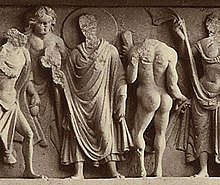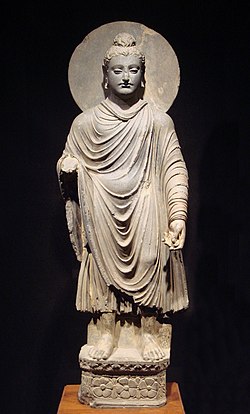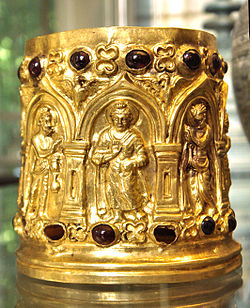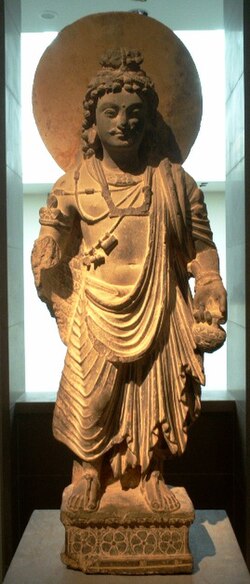
Back الفن اليوناني البوذي Arabic Грэка-будысцкае мастацтва Byelorussian Art grecobudista Catalan Gandhárské umění Czech Ελληνοβουδιστική τέχνη Greek Arte greco-budista Spanish Gandhāra kunst Estonian هنر یونانی و بودایی Persian Art gréco-bouddhique French गान्धार कला Hindi
Top: Standing Buddha from Gandhara, 1st-2nd century AD Centre: The Bimaran casket, representing the Buddha, is dated to around 30–10 BC. British Museum; Bottom: The Bodhisattva Maitreya, 2nd century AD, Gandhara | |
| Years active | 1st century B.C. -5th century A.D. |
|---|---|
The Greco-Buddhist art or Gandhara art is the artistic manifestation of Greco-Buddhism, a cultural syncretism between Ancient Greek art and Buddhism. It had mainly evolved in the ancient region of Gandhara, located in the northwestern fringe of the Indian subcontinent.
The series of interactions leading to Gandhara art occurred over time, beginning with Alexander the Great's brief incursion into the area, followed by the Mauryan Emperor Ashoka converting the region to Buddhism.[citation needed] Buddhism became the prominent religion in the Indo-Greek Kingdoms. However, Greco-Buddhist art truly flowered and spread under the Kushan Empire, when the first surviving devotional images of the Buddha were created during the 1st-3rd centuries CE.[1] Gandhara art reached its zenith from the 3rd-5th century CE, when most surviving motifs and artworks were produced.[1]
Gandhara art is characterized by Buddhist subject matter, sometimes adapting Greco-Roman elements, rendered in a style and forms that are heavily influenced by Greco-Roman art. It has the strong idealistic realism and sensuous description of Hellenistic art, and it is believed to have produced the first representations of Gautama Buddha in human form, ending the early period of aniconism in Buddhism.[2]
The representation of the human form in large sculpture had a considerable influence, both to the south in the rest of India, and to the east, where the spread of Buddhism carried its influence as far as Japan.[3]



